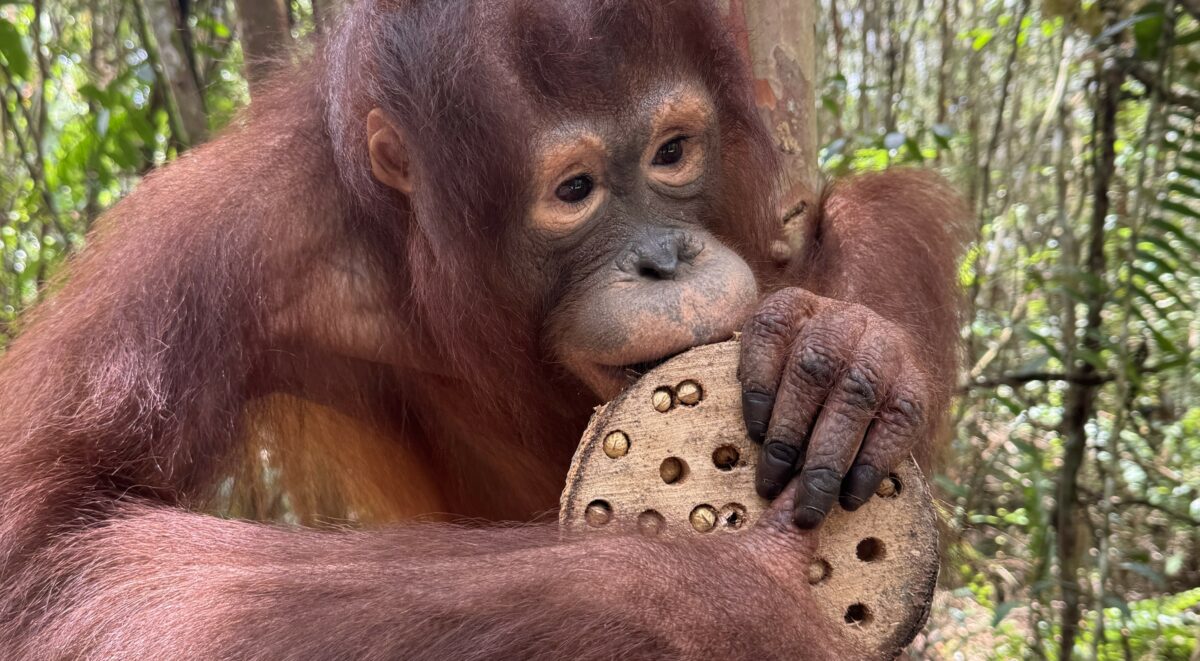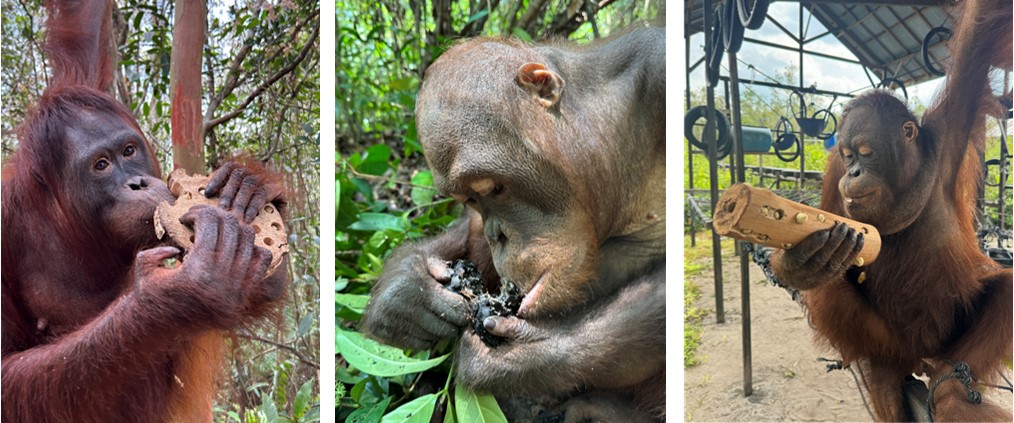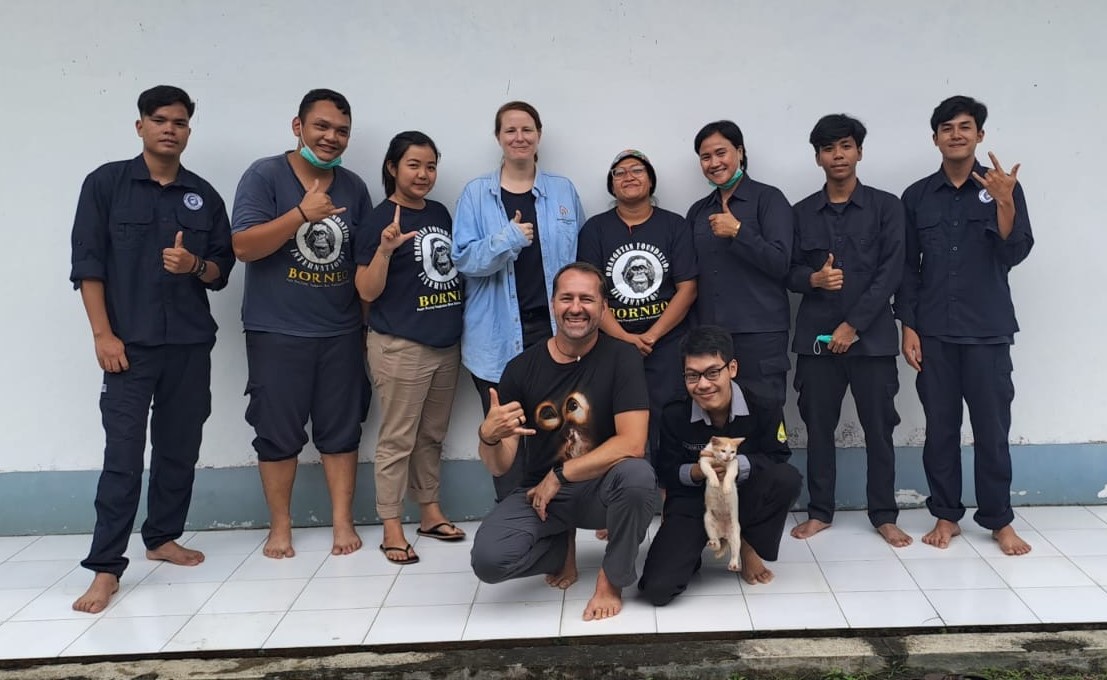
By Darek Figa, OFI Australia Director and behavioural enrichment expert.
 Recently I had the opportunity to visit the OFI Orangutan Care Centre and Quarantine to assist with their ongoing enrichment program. Having had over 30 years of experience with enrichment across many species, I was able to help evaluate existing techniques and explore new ideas.
Recently I had the opportunity to visit the OFI Orangutan Care Centre and Quarantine to assist with their ongoing enrichment program. Having had over 30 years of experience with enrichment across many species, I was able to help evaluate existing techniques and explore new ideas.
Behavioural enrichment (or environmental enrichment) is the number one animal welfare tool. Enrichment is applied ONLY to animals held in captivity, and not applicable to those in the wild. It might surprise some that captivity includes dogs in backyards, birds in cages, and even reptiles and fish in tanks!
It’s not applicable to wild animals because they are busy attending to their needs. They forage for food when hungry and water when thirsty; connect socially for comfort, security or reproduction; seek shelter to hide from predators, weather, or to roost and nest – and all depend upon navigating species appropriate corridors or pathways that link these needs together. They also spend just the right amount of time on these needs too – a balanced time budget. They keep busy with problem solving choices and using physical activity. This keeps animals healthy and releases feel good neurotransmitters. They don’t suffer depression nor show abnormal behaviours. The most wonderful thing is that wild animals are in control of their well-being – and they’ve been doing great for millions of years!
However, in captivity, we control access to their needs and determine their well-being. When compared to the wild, diets are predictable, social contact is restricted, shelter is basic, and few corridors are in place to stimulate movement. Captivity also credits animals with an abundance of captive time, which they have little to occupy that time with. This can lead to boredom, displaced and abnormal behaviour, and potentially long term depression in severe cases. This can be the impact of limited choices.
 So our responsibility is to ensure we understand captive animals’ needs and provide the choices that allow an animal to meet its needs in a healthy time budget. These time occupying strategies are the core role of enrichment – to trigger the right behaviours for the correct amount of time.
So our responsibility is to ensure we understand captive animals’ needs and provide the choices that allow an animal to meet its needs in a healthy time budget. These time occupying strategies are the core role of enrichment – to trigger the right behaviours for the correct amount of time.
For an orangutan the forest provides food, water, social contact, shelter and the pathway to move through it to access these key resources. This is another reason why we must protect their habitat. It’s not just their home, but also a complex supermarket of problem-solving choices that allows them to manage their own well-being. Perfect!
Our Care Centre enrichment program is run by Ibu Maryanti and her team of 8 to 10 enrichment staff. Their focus is to create daily opportunities of unpredictable choice that trigger problem-solving behaviours across all of the orangutans – some 280 animals across 8 to 12 camps! To achieve this, the team uses a range of enrichment techniques focused on food puzzles, climbing frames, and hammocks that trigger movement and mental stimulation.
Some items require the orangutan to use tools, such as sticks, to reach for a piece of food suspended by twine. In this case, the orangutan must problem solve which stick based on how much reach they need, and the angle and force applied to bring the twine forward and close enough to then grab the treat.
Other items require them to unravel a tightly packed ball or layered tube and search for a hidden treat within, or climb to the top of their cage to access frozen blocks of fruit and juice – in both cases this forces the animals to use their muscles, thus increasing their strength whilst searching for food. At times they also receive a crunchy termite nest – which orangutans love. Some will gently tap the nest whilst others rip it open, some then blow softly pushing termites out only to then lick or suck them up one by one – each has a unique way to solve the termite nest problem. Just as they would in the wild!
 Enrichment items that are bought are all natural in texture, colour, and taste. This ensures that animals don’t imprint on man-made objects or colour and be drawn to these items after their release. It also reduces the possibility of exposure to toxins. Natural items are also used. Each morning the team sets out across the forests looking for vine, invertebrates, and leaf. Local fruits such as rambutan, durian, banana, jack fruit, peanuts, carrot and much more are delivered. The team then busily creates puzzles, or freezes a range of puzzle blocks for future use. Once ready, the items are selected for distribution based on priority needs – first being the large single housed males, then those housed in small groups of 2-3, and finally the infants.
Enrichment items that are bought are all natural in texture, colour, and taste. This ensures that animals don’t imprint on man-made objects or colour and be drawn to these items after their release. It also reduces the possibility of exposure to toxins. Natural items are also used. Each morning the team sets out across the forests looking for vine, invertebrates, and leaf. Local fruits such as rambutan, durian, banana, jack fruit, peanuts, carrot and much more are delivered. The team then busily creates puzzles, or freezes a range of puzzle blocks for future use. Once ready, the items are selected for distribution based on priority needs – first being the large single housed males, then those housed in small groups of 2-3, and finally the infants.
The infants also get daily playtime in complex jungle gyms and trees! Here they not only search for food (as they would if they were in a forest) but doing so involves significant climbing, stretching, swinging, and social interaction. It’s amazing to watch their social behaviour and developing problem solving skills.
All of these opportunities ensure that the animals stay mentally fit, physically strong, and together with their regular diet they are also physiologically healthy. Not only does enrichment help offset abnormal behaviours, it also ensures that the orangutans are a step closer to being ‘release ready’ when suitable habitat is secured for their transition back into the wild.
During my visit, I also ran an enrichment workshop for the enrichment team and broader animal care staff. We reviewed current and future techniques, which helped cement, an understanding of enrichment applications and strategies. Most importantly the team left with the understanding that behavioural enrichment is a powerful animal welfare tool. It is vital for rescued orangutans waiting to be returned to their forest homes.
Ibu Maryanti and her team do an amazing job. They work hard each day, in hot humid conditions, sometimes in heavy downpours, delivering a range of behavioural stimulation to the animals in their care. Without the enrichment team these animals would be worse off.
And remember – enrichment is for all animals housed in captivity. So what could you do for your pet? Perhaps scatter feed your dog, squirt nectar on bottlebrush for lorikeets, or even provide your cat with a tree stump to claw (they will then stop destroying your lounge!). So problem solve your way into your animals’ lives and stay enriched!



